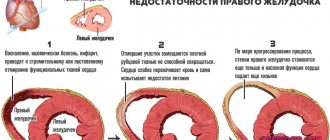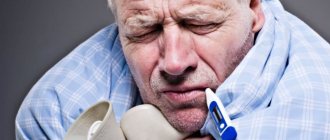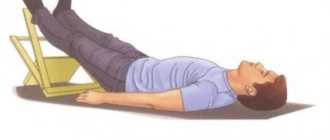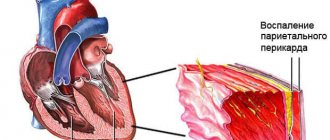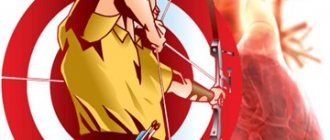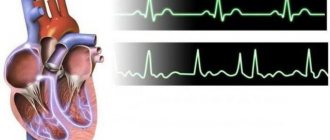One of the acute forms of vascular insufficiency is called collapse. It occupies an intermediate position between fainting and a state of shock. It is characterized by a drop (collapse means fallen) pressure, dilation of veins and arteries with the accumulation of blood in them.
It happens with infections, allergies, blood loss, insufficient functioning of the adrenal glands, or under the influence of strong antihypertensive drugs. Treatment requires emergency hospitalization and administration of drugs that increase systemic pressure.
Causes of acute vascular collapse
The following can lead a patient to a collaptoid state:
- sharp pain;
- injuries;
- blood loss, general dehydration;
- acute infectious processes;
- low cardiac output (heart attack, cardiomyopathy, narrowing of valve openings);
- severe allergic reactions;
- intoxication due to internal (kidney, liver, intestinal diseases, acute inflammation) or external (various poisonings) entry of toxic substances into the blood;
- administration of drugs for general or spinal anesthesia, barbiturates, overdose of sleeping pills, narcotics, medications for the treatment of arrhythmia, hypertension;
- decreased synthesis of catecholamines in the adrenal glands;
- a drop in blood sugar or its sharp increase.
Determining the cause of collapse is not difficult if it occurs against the background of an existing disease. When it develops suddenly, it is the first manifestation of emergency conditions (for example, ectopic pregnancy, bleeding from a stomach ulcer). In older people, acute vascular insufficiency often accompanies myocardial infarction or pulmonary embolism.
We recommend reading the article on vascular tone. From it you will learn why vascular tone is needed and what affects it, as well as the mechanism of regulation and how to increase or decrease vascular tone. And here is more information about the use of the drug Isoket.
Characteristic symptoms
Before providing first aid for shock, fainting and collapse, you need to assess the condition of the victim.
The symptoms of an attack caused by a lack of circulating blood are pronounced. The main signs that the victim needs first aid are as follows:
- Sudden deterioration in general health;
- Headaches accompanied by dizziness;
- The victim feels weak, his vision becomes dark, and noise is heard in the ears;
- A barely audible but very rapid pulse;
- Reducing blood pressure to critical levels;
- The skin quickly turns pale, then turns blue;
- There is discomfort in the heart area;
- Due to a decrease in body temperature, the patient feels cold and chilly;
- Frequent, intermittent and shallow breathing;
- Confusion of consciousness, which manifests itself in the patient’s complete indifference to everything that happens;
- The face is covered with cold sweat, the tongue is dry;
- Nausea leading to vomiting is possible;
- Sharpening of facial features.
In a very serious condition, if first aid is not provided in time for collapse, fainting will occur with the loss of all reflex movements or shock.
It should be noted that vascular collapse is a less dangerous pathology than cardiac collapse. However, in this case, delay on the part of rescuers or a doctor will cost the victim his life.
Symptoms of deficiency
The first signs of collapse are sudden general weakness, yawning, and dizziness. Then they quickly join:
- cold clammy sweat;
- a feeling of fear, anxiety and excitement, followed by apathy and lethargy;
- pallor of the skin with a marbled pattern; Cold sticky sweat
- visual impairment;
- noise in ears;
- nausea;
- change in consciousness;
- frequent and shallow breathing;
- irregular heart contractions;
- decrease in body temperature
Blood pressure decreases as the severity of the vascular reaction increases, but its values must be correlated with the initial values; in hypertensive patients with a pressure of 100/70 mm Hg. Art. the condition can be quite severe, and for a hypotensive person this is considered normal. Systolic and pulse pressure drops more often, diastolic pressure changes depending on the cause of the collapse.
Heart sounds are normal or louder than usual; in case of poisoning or low cardiac output, they are muffled, and rhythm disturbances are noted. The pulse is rapid, thread-like, arrhythmic, and during severe attacks it may slow down or become undetectable.
Types of collapse
Depending on the clinic and pathogenesis, collapse is divided into three types:
- Sympathotonic. This form of collapse is accompanied by increased tone of the sympathetic nervous system, which leads to spasm of the arteries throughout the body. Systolic pressure in such situations is normal or slightly elevated, and diastolic pressure is high. If such a collapse is observed, emergency care is required urgently so as not to develop more serious complications.
- Vagotonic collapse. In this state, the parasympathetic system comes into tone. The arteries, on the contrary, dilate, diastolic pressure decreases, and bradycardia is observed. The cause of this condition is fear, fainting, hypoglycemic coma.
- Paralytic. Most often it happens when the mechanisms that are responsible for regulating blood circulation are severely depleted. The vessels dilate, the pressure drops, and collapse occurs; emergency care comes down to normalizing, first of all, blood pressure.
How to distinguish collapse from fainting
Collapse, in its clinical manifestations, is a severe variant of a decrease in vascular tone. With it, unlike fainting, the primary process is the dilation of arteries and veins with the accumulation of blood in them. As a result, the volume of blood circulating in the bloodstream and returning to the heart decreases. The consciousness of patients remains intact until the collapse progresses to a severe form, accompanied by impaired cerebral blood flow.
When fainting, a spasm of cerebral vessels occurs, and even with a mild form, patients lose consciousness. It is also important to distinguish collapse from shock . In the latter case, heart failure, severe metabolic disorders and neurological disorders occur. It should be noted that the boundary between these conditions (fainting, collapse, shock) is often quite arbitrary; they can transform into each other as the underlying disease progresses.
What is collapse?
In a simplified view, collapse is fainting. There is a sharp change in body position, during which the pressure drops to critical levels. This is an acute form of vascular insufficiency. A condition characterized by a decrease in vascular tone and, as a result, a significant deterioration in the functioning of the circulatory system.
If you provide emergency assistance, you can avoid unpleasant complications.
If you provide emergency first aid in case of collapse, you can avoid unpleasant complications or save the life of the victim. With heart failure, blood flow decreases, internal organs do not receive enough nutrition, brain activity deteriorates and asphyxia develops. Prolonged stay in this state in the absence of help threatens the suppression of vital functions.
Types of collapses
Depending on the causes and leading mechanism of development, several types of vascular collapse have been identified:
- orthostatic - with a sharp change in body position in case of ineffective regulation of arterial tone (recovery from infections, taking antihypertensive drugs, rapid decrease in body temperature, pumping fluid from cavities, uncontrollable vomiting);
- infectious – a decrease in arterial tone occurs under the influence of bacterial or viral toxins;
- hypoxic – occurs when there is a lack of oxygen or low atmospheric pressure;
- dehydration – it is caused by loss of fluid during severe infections with diarrhea and vomiting, excessive excretion of urine during forced diuresis, diabetes mellitus with high hyperglycemia, and internal or external bleeding;
- cardiogenic – associated with myocardial damage during heart attack, myocarditis, cardiomyopathy;
- sympathicotonic – blood loss or dehydration, neuroinfection, occurs with vascular spasm with normal blood pressure, rapid pulse;
- vagotonic – severe pain, stress, anaphylaxis, drop in blood sugar or lack of adrenal hormones. A sharp difference between systolic and diastolic pressure, bradycardia;
- paralytic - severe diabetes, infectious processes, depletion of compensation reserves, paralytic vasodilation with a sharp decrease in blood circulation.
According to the severity of the patient's condition, there are:
- mild - the pulse increases by a third, the pressure is at the lower limit of normal, the pulse (the difference between systolic and diastolic) is low;
- moderate severity - heart rate increased by 50%, pressure about 80-60/60-50 mm Hg. Art., urine output decreases;
- severe - consciousness changes to a state of stupor, lethargy, pulse is increased by 80 - 90%, maximum pressure is below 60 mm Hg. Art. or not determined, anuria, intestinal motility arrest.
Syncope, collapse
In the group of paroxysmal disorders encountered by a practical neurologist, a special place is occupied by such manifestations of acute vascular insufficiency as fainting (syncope) and collapse. Fainting, or syncope, is the most common.
Fainting a short-term loss of consciousness due to anemia of the brain. A typical symptom complex of the most common syncope: sudden (within 1-3 minutes) onset of impairment of consciousness with a decrease in blood pressure, weakening of the pulse, paleness of the face, dilation (sometimes constriction) of the pupils, absence of their photoreaction, deep depression of corneal and proprioceptive reflexes, sweating, muscle hypotension, shallow slow breathing, often with a fall, bruises and usually spontaneous normalization of the condition. The electroencephalogram shows slow wave activity. 8% of patients experience tonic convulsions, 4% have involuntary urination, and 2% have defecation.
There are 3 stages of fainting:
- presyncope - weakness, tinnitus, darkening of the eyes, sweating and other autonomic disorders;
- loss of consciousness with a fall;
- recovery from fainting.
In this case, the patient's well-being depends on the duration of fainting . The average duration of fainting is several minutes, in rare cases - up to 10-20 minutes.
that provoke syncope are emotional stress, rapid transition from a horizontal to a vertical position or from a sitting to a standing position, prolonged standing, overheating, severe pain, staying in a stuffy room, traveling in transport, allergic reactions, less often - pregnancy, fever, cough , urination, rapid breathing, taking medications.
Contributing factors: mental and physical stress, infectious and somatic diseases, ethanol intoxication, food toxic infections, arterial hypotension, vegetative-vascular dystonia with parasympathetic tension and insufficiency of vegetative support of activity, respiratory form of vegetative dystonia with symptoms of latent tetany, prolonged hypokinesia, primary or secondary progressive autonomic failure (Shay-Drager, Reilly-Day syndromes, etc.).
There are no generally accepted classifications of fainting conditions. The classifications of A.M. Korovin and G.A. are of practical importance. Akimov and co-authors. According to AM Korovin, fainting is divided into reflex (vasovagal - emotiogenic and painful; sinocarotid, orthostatic, vestibular) and symptomatic (cardiac, pulmonary, homeostatic). Korovin considers homeostatic syncope to be fainting due to internal bleeding, hypoglycemia, hypocapnia, anemia, hypoxia, hypocalcemia, hypokalemia and basilar discirculation.
The most detailed classification is G.A. Akimov and co-authors. There are 4 groups of syncope:
- neurogenic;
- somatogenic;
- developing as a result of exposure to extreme conditions;
- rare multifactorial syncope.
Neurogenic fainting includes emotiogenic (arising as a result of acute emotional stress); associative (developing in conditions reminiscent of those in which fainting initially occurred); irritative (with neuralgia of the glossopharyngeal nerve, damage to the carotid sinus, cardiospasm, reflex effects of the gallbladder, duodenum, esophagus, diaphragm); discirculatory (for pathological processes in the carotid arteries, hypertension and atherosclerosis); maladaptive (with prolonged standing, getting up quickly, overheating, intense physical activity, adverse external influences).
Somatogenic include fainting due to diseases of the heart and blood vessels (valvular defects, angina pectoris, myocardial infarction, pulmonary embolism, myocarditis, myocardial dystrophy, asymmetrical hypertrophy of the cardiac septum, cardiac arrhythmia), pulmonary pathologies (pneumosclerosis, emphysema, other diseases accompanied by decreased vitality). lung capacity, cough, hyperventilation and increased intrathoracic pressure), diseases of the digestive canal, endocrinopathies (hyperinsulinism, diabetes mellitus, hypopituitarism, Addisonism, etc.).
Fainting as a result of extreme external influences is caused by exogenous hypoxia, neurotoxicosis, the influence of pharmacological agents, intense acceleration, decompression, breathing under excess pressure, and massive blood loss.
Rarely occurring multifactorial syncope conditions are urinary syncope and cough syncope (bettolepsy).
Urinary syncope is characterized by sequentially developing 1-2 fainting spells after urination with an interval of 3-5 minutes. In some cases, serious injury can occur. Fainting usually occurs at night.
Bettolepsy is characterized by short-term (for 1-2 minutes) blackouts and the patient falling while coughing. The closest harbingers of paroxysm are increasing weakness that occurs against the background of cough hyperventilation, sometimes paresthesia in the limbs and in the mouth. During an attack, cyanosis may occur, turning into pallor. There are no cramps or tongue biting. The attack ends quickly, with the patient experiencing general weakness and often a dull headache.
Clinical features are present in syncope associated with hypersensitivity of the receptor apparatus of the aorta and carotid sinus. V.M. Gabashvili and co-authors described 3 variants of paroxysms that occur when the above structures are affected (vegetative, ictal and mixed variants). Paroxysms of the first type occur with hemodynamic and respiratory disorders, which after a certain time are superimposed by secondary ones caused by hypoxic disorders (loss of consciousness, tonic convulsions, trismus, mydriasis, hypersalivation, rolling of the eyes).
Ictal paroxysms can occur in the form of orthostatic syncope, simple or myoclonic syncope. Epileptiform seizures without hemodynamic disturbances may occur.
Ictal and mixed paroxysms can transform into epileptic (convulsive and non-convulsive) with the formation of typical EEG patterns.
The central link in the pathogenesis of syncope is a decrease in circulating blood volume (CBV) as a result of hyposystole caused by disruption of the heart and peripheral circulation (a decrease in total peripheral resistance due to dilation of arterioles or deposition of blood in the venous system with limited venous flow to the heart). The above mechanisms can be combined, as happens with hypersensitivity of the sinocarotid apparatus.
The diagnosis of fainting is based on the clinical picture. Differential diagnosis is carried out with epileptic and hysterical seizures, collapse. The differentiation of fainting from a fainting-like form of epilepsy is especially difficult. The following evidence in favor of fainting-like variants of epilepsy is the discrepancy between the functional significance of provoking factors and the severity of paroxysms; serial occurrence of attacks with an interval of several minutes; originality of the nosoclinical period (headache, sleep, confusion); cases of epilepsy among close relatives (in siblings or along the vertical family tree); identification in a series of fainting attacks of isolated seizures of a clearly epileptic nature, not only with tonic, but also with clonic convulsions, with biting of the tongue, cheeks, foam at the mouth, noisy breathing, turning towards the head and eyes; changes in the EEG with trigger stimulation; absence of presyncope stage. Sometimes there is an aura in the form of short-term psychosensory disorders, unmotivated fear, deceptions of perception, pain in the abdomen or heart, and the urge to defecate.
According to G. A. Akimov, clear (with a probability of less than 0.1%) differences are determined in the range of EEG parameters. Syncope-like epilepsy is characterized by: the dominant frequency of the alpha rhythm - 9.64 - 9.92 oscillations per 1 s (count/s); minimum frequency - 9.17-9.63 counts/s; maximum frequency - 10.22 - 10.64 counts/s; theta wave index - 20.79 - 28.1; amplitude of delta waves - 59.06-74.03 µV.
In syncope, the dominant frequency of the alpha rhythm is 10.15 - 10.45 beats/s; minimum frequency - 9.76 - 10.14 counts/s; maximum frequency - 10.80 - 11.14 counts/s; theta wave index - 15.19-19.13; amplitude of delta waves - 45.77-57.68 µV.
Epilepsy, with a probability of less than 0.001%, is characterized by hypersynchronous generalized high-amplitude paroxysmal discharges of predominantly slow waves and bilateral synchronous outbreaks of “peak-wave” and “sharp wave-slow wave” complexes.
Hysterical attacks occur without significant hemodynamic disorders, usually in persons with personality changes inherent in this neurosis.
In order to clarify the pathogenesis of syncope, autonomic tone, autonomic reactivity and autonomic support of activity are examined. It has been established that with emotiogenic fainting, autonomic reactivity and tone of the sympathetic part of the autonomic nervous system are increased. With maladaptive fainting, the tone of the parasympathetic part is increased and the insufficiency of autonomic support is clearly expressed (impaired ergotropic function of the autonomic nervous system).
In terms of diagnostics, it is recommended to study hemodynamics using echocardiography, thoracic tetrapolar rheography, mechanocardiography, bulbar capillaroscopy, and in some cases by measuring diastolic pressure in the ophthalmic artery and systolic pressure in the temporal artery. REG and Dopplerography are also used. Biochemical methods are of great importance (especially for homeostatic fainting).
fainting occurs, the patient is placed on the bed with the foot end slightly raised. It is recommended to open the window, spray the patient’s face with cold water or wipe with a damp towel, pat the cheeks with your palms, let the vapors of ammonia inhale, rub your torso, legs and arms with your hands, and cover with warm heating pads. If fainting persists, then 1 ml of a 10% solution of cordiamine (for children at a dose of 0.02 mg/kg body weight) or 1 ml of a 10-20% solution of caffeine (for children at a dose of 0.03 mg/kg body weight) is injected subcutaneously or intramuscularly. , or 3-5 ml of 1% solution of etimizol.
A more severe form of acute vascular insufficiency is collapse. There is no generally accepted classification of collapses. Depending on the etiology, clinicians distinguish forms associated with massive blood loss, infections, intoxication, hypoxia, acute diseases of internal organs (pancreatitis, peritonitis, cardiac pathology, etc.), allergic factors, electrical trauma, overheating, ionizing radiation.
The main pathogenetic mechanisms of collapse are a decrease in the tone of arterioles and veins, a decrease in the capacity of the vascular bed, blood deposition, a decrease in blood volume, a decrease in venous flow to the heart with an increase in heart rate and a decrease in blood pressure. As a consequence, a secondary disturbance of microcirculation occurs with a cascade of biochemical changes characteristic of tissue hypoxia, the development of metabolic acidosis and disseminated intravascular coagulation syndrome. A pronounced collaptoid state occurs with cerebral edema.
Symptoms. In all variants of collapse, consciousness is preserved, but the patient is indifferent to his condition and surroundings. The skin is pale, the mucous membranes, the tip of the nose and the distal parts of the extremities are cyanotic. The body is covered with cold sticky sweat, body temperature is reduced, shallow breathing is rapid, sometimes slow (without a feeling of lack of air). The pulse is of reduced filling and tension, rapid, less often slow, in some cases arrhythmic. Blood pressure is reduced, superficial veins are in a collapsed state, central and peripheral venous pressure is reduced, heart sounds are muffled. Oliguria, nausea and vomiting develop.
A biochemical blood test reveals a violation of the acid-base state with a shift towards acidosis, blood thickening, and an increase in the oxygen content in the venous blood (shunt effect).
The severity of collapse and its prognosis depend on the etiology, age of the patient and the degree of adaptation to hypoxia.
Features of vascular insufficiency in children
In childhood, a common cause of collapse is infection, dehydration, intoxication and oxygen starvation due to diseases of the lungs, heart, and nervous system.
Minor external influences can lead to vascular insufficiency in premature and weakened children. This is due to the physiological inferiority of the mechanisms regulating the tone of arteries and veins, the predominance of vagotonia, and the tendency to acidosis (a shift in the blood reaction to the acidic side) in this category of patients.
Signs of the onset of a collaptoid reaction are a deterioration in the child’s condition - against the background of the underlying disease, severe weakness, lethargy and even adynamia (low motor activity) appear.
There is chills, pale skin, cold hands and feet, increased heart rate, which becomes thread-like. Then the blood pressure decreases, the peripheral veins lose their tone, while maintaining consciousness, children lose their reaction to their surroundings, and convulsive syndrome is possible in newborns.
Symptoms of collapse
Symptoms relevant to this condition include the following:
- A sharp deterioration in health;
- The appearance of tinnitus, weakness, headache;
- Darkening in the eyes;
- Shallow and rapid breathing;
- Dim look;
- Cold, damp, pale skin;
- Weak pulse.
It should be noted that collapse, in which first aid is not provided for one reason or another, can lead to loss of consciousness of a person. Basically, the preservation of consciousness is noted, despite its general fog; in addition, the patient’s complete indifference to what is happening around him is noted. There is also a sluggish reaction of the pupils to light and tremor of the hands.
Emergency care before the ambulance arrives
Collapse can only be treated in a hospital, so you should call emergency help as quickly as possible. All the time before the doctor arrives, the patient must be in a horizontal position with his legs raised (place a blanket or clothes rolled up in a cushion).
It is necessary to ensure the flow of fresh air - unfasten the collar, loosen the belt. If the attack occurred indoors, then you need to open the windows, while covering the victim with a warm blanket. Additionally, you can apply a warm heating pad or bottles of non-hot water to the sides of the body.
To improve peripheral blood circulation, rub the hands, feet, and press the ears into the cavity between the base of the nose and the upper lip. You should not try to sit the patient up or give him medications yourself, since the most common drugs (Corvalol, No-shpa, Validol, especially Nitroglycerin) can significantly worsen the condition and turn collapse into shock. For external bleeding, apply a tourniquet.
Watch the video about first aid for fainting and vascular collapse:
First aid for collapse
Before providing emergency assistance in case of collapse, you need to call a team of doctors, and only then begin rehabilitation measures. Assess the condition of the victim, try to find out what could have caused the deterioration in health, whether he suffers from heart disease.
It is extremely important not to delay if collapse occurs in children, as there is a risk of accelerated development of complications.
The collapse assistance algorithm includes the following actions:
- help the person find a comfortable position, placing him face up;
- Raise your legs, put something under them to give the position above the level of your heart. Use a pillow or rolled up clothing;
The victim must be laid down and his legs raised using available means. - help the person come to his senses. Use a cotton swab soaked in ammonia. Then, when the victim returns to consciousness, turn his head to the side;
- if clothing presses and interferes with breathing, it must be removed or loosened. Provide fresh air by opening a window. If people are gathered nearby, tell them to move away so as not to interfere with circulation;
- for extremities, use warm heating pads or blankets, as they can become cold;
If necessary, help the patient warm up. - if the cause of collapse is excessive blood loss, it is necessary to provide assistance to stop it. Proceed depending on the type of bleeding. For venous, apply a tight bandage; for arterial, clamp the vessel or use a tourniquet.
Do not disturb the victim and ensure complete rest until the ambulance arrives. If a person is unconscious, do not give him water, shake him or try to give him any drugs.
Medical therapy
Before transporting the patient to the hospital, the introduction of vasoconstrictors can be used - Cordiamin, Caffeine, Mezaton, Norepinephrine. If collapse occurs due to loss of fluid or blood, then the administration of such drugs is carried out only after restoration of the volume of circulating blood with the help of Reopoliglucin, Stabizol, Refortan or saline solutions.
In severe cases and in the absence of peptic ulcer, hormonal drugs (Dexamethasone, Prednisolone, Hydrocortisone) are used.
Inhalation of humidified oxygen is indicated for patients with hypoxic collapse, carbon monoxide poisoning, and severe infections. In case of intoxication, infusion therapy is carried out - the introduction of glucose, isotonic solution, and vitamins. In case of bleeding, blood transfusions or plasma substitutes are used.
Patients with heart failure additionally receive cardiac glycosides; in case of arrhythmia, it is necessary to restore the rhythm with the help of Novocainamide, Cordarone, Atropine (for conduction block, bradycardia). If collapse develops against the background of a severe attack of angina or heart attack, then intravenous administration of neuroleptics and narcotic analgesics and anticoagulants is carried out.
Collapse. Prevention
Prevention consists of intensive treatment of the underlying disease, constant monitoring of patients in severe and moderate condition; In this regard, monitoring plays a special role.
It is important to take into account the characteristics of the pharmacodynamics of drugs (ganglionic blockers, neuroleptics, antihypertensive and diuretics, barbiturates, etc.), allergy history and individual sensitivity to certain drugs and nutritional factors.
Forecast
With the rapid elimination of the cause of collapse, it is possible to completely restore normal hemodynamic parameters and recover the patient without consequences. For infections and poisonings, adequate and timely therapy is also often quite effective.
The prognosis is more severe for patients with chronic, progressive diseases of the heart, digestive organs, and pathology of the endocrine system. In such patients, repeated, repeatedly recurrent collaptoid conditions are especially dangerous. Due to the age-related characteristics of the body, collapse is most dangerous for children and the elderly.
Collapse. Forecast
Quick elimination of the cause of the collapse often leads to complete restoration of hemodynamics.
In severe diseases and acute poisoning, the prognosis often depends on the severity of the underlying disease, the degree of vascular insufficiency, and the age of the patient.
If therapy is insufficiently effective, collapse may recur. Repeated collapses are more difficult for patients to endure.
Causes of collapse
Many reasons can cause a condition such as collapse:
- Severe blood loss after injuries, internal bleeding.
- Many infectious diseases, for example, hepatitis, scarlet fever, pneumonia.
- Girls are going through puberty.
- In the case when a patient, who has been lying down for a long time, tries to get up abruptly.
- Dehydration.
- Electric shock.
- Heatstroke.
- Exposure to ionizing radiation, especially in high doses.
- Poisoning with food or certain medications.
If collapse occurs as a result of the above reasons, emergency care will depend on them. In each case the steps will be different.
